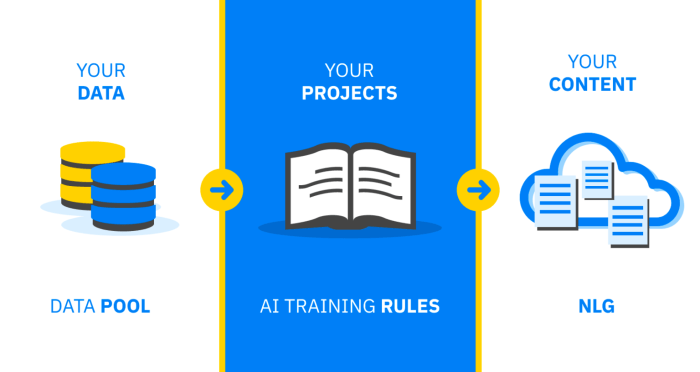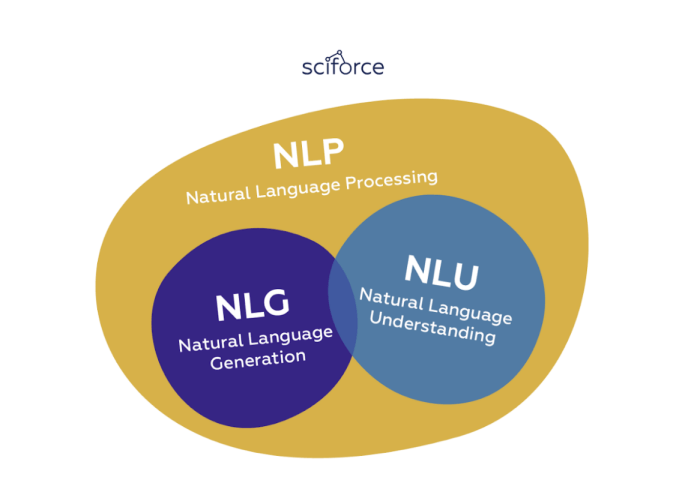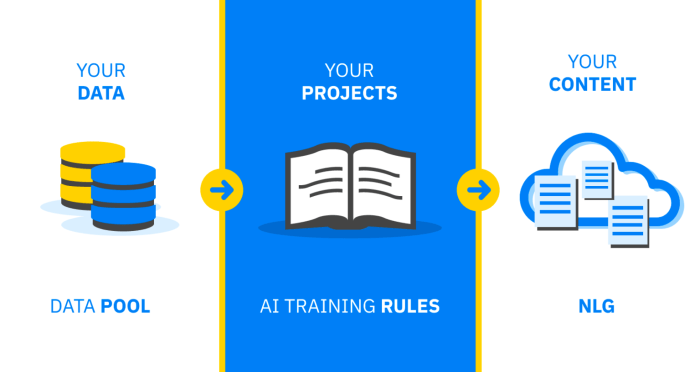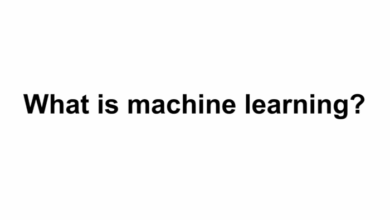
Definition of natural language generation nlg – Definition of natural language generation (NLG): NLG is the process of converting data into human-readable text. Imagine a computer crafting a compelling news summary, composing a personalized email, or even writing a creative story. This process, at its core, involves complex algorithms that transform structured information into coherent and engaging language. From simple summaries to sophisticated narratives, NLG is transforming how we interact with information in the digital age.
This exploration delves into the intricacies of NLG, examining its key components, diverse techniques, and real-world applications. We’ll unravel the fundamental principles behind text planning, sentence planning, and surface realization, while exploring how NLG systems are being utilized in various industries. We’ll also look at the challenges NLG faces and the exciting future directions for this rapidly evolving technology.
Introduction to Natural Language Generation (NLG)
Natural Language Generation (NLG) is a crucial component of artificial intelligence, enabling computers to create human-readable text from structured data. This process involves transforming information stored in databases, knowledge graphs, or other structured formats into natural language, ensuring the output is grammatically correct, semantically coherent, and stylistically appropriate. Understanding the different stages and types of NLG systems is key to appreciating its wide-ranging applications.NLG systems operate by processing underlying information and converting it into a comprehensible human language representation.
The core concepts of text planning, sentence planning, and surface realization are fundamental to this process, allowing for the creation of meaningful and well-structured text. Different NLG approaches address diverse needs, from summarizing complex data to crafting engaging narratives.
Defining Natural Language Generation
Natural Language Generation (NLG) is the process of automatically producing human-readable text from a computer database or knowledge base. It involves several key stages to ensure the generated text is coherent, grammatical, and relevant to the source information.
Fundamental Concepts of NLG
NLG operates through a series of stages, ensuring the generated text aligns with the underlying data and is understandable by humans.
- Text Planning: This initial stage involves determining the content of the text, focusing on what information to include and how to structure it for optimal clarity. This includes selecting relevant data points, identifying relationships between them, and organizing the information into a logical sequence. A well-structured text plan leads to a more coherent and meaningful output.
- Sentence Planning: At this stage, the planned text is further refined into individual sentences. This step focuses on the grammatical structure of each sentence and how individual sentences relate to each other within the overall text. This process involves deciding on the appropriate sentence structure and vocabulary to ensure the generated text is clear and grammatically sound.
- Surface Realization: This final stage transforms the planned sentences into actual text. This includes selecting specific words, determining the syntax, and ensuring the final text is stylistically appropriate. This involves considering factors such as tone, style, and intended audience.
Types of NLG Systems
Different types of NLG systems cater to various needs, from simple data summarization to complex narrative generation.
- Template-based NLG: This method utilizes pre-defined templates to generate text. The templates are filled with specific data from the source, ensuring consistency and speed in generating outputs. This approach is suitable for straightforward data summaries and reports.
- Rule-based NLG: This method uses predefined rules and algorithms to structure the output text. These rules dictate how information is combined to create sentences and paragraphs, ensuring a consistent and controlled style. This approach is suitable for generating reports, summaries, and other formal texts.
- Statistical NLG: This method leverages statistical models to predict the most appropriate words and sentence structures based on the input data. This approach often relies on large corpora of text data to identify patterns and relationships, enabling the generation of more complex and nuanced text. This approach is commonly used in applications requiring a more flexible and adaptable output.
Applications of NLG
NLG is a powerful tool with a broad range of applications in various fields.
- Chatbots: NLG powers chatbots by enabling them to generate human-like responses to user queries. This allows for more engaging and informative interactions, particularly in customer service or information retrieval scenarios.
- Summarization Tools: NLG is used to create concise summaries of lengthy documents or datasets. This allows users to quickly grasp the essential information without needing to read the entire source material.
- Content Creation: NLG can assist in generating various types of content, such as news articles, product descriptions, or marketing materials. This can significantly speed up content production and make it more efficient.
Key Components of NLG Systems

Natural Language Generation (NLG) systems are intricate mechanisms that transform structured data into human-readable text. Understanding the internal workings of these systems is crucial for appreciating their capabilities and limitations. This involves recognizing the key components and how they interact to produce coherent and meaningful output.The core components of an NLG system work in a carefully orchestrated manner to convert data into natural language.
Each stage plays a specific role, contributing to the overall quality and accuracy of the generated text. These stages build upon each other, ensuring that the final output is a well-formed, grammatically correct, and meaningful sentence.
Text Planning
Text planning is the initial stage where the system determines the overall content and structure of the text. It decides which information is important and how that information should be presented. This stage essentially maps the structured data into a more abstract representation of the intended message. This involves considering factors such as the target audience, the purpose of the text, and the context in which it will be used.
For instance, a system generating a weather report will focus on different information compared to one generating a product description.
Sentence Planning
Following text planning, the system moves to sentence planning. This module focuses on the specific sentences that will make up the text. It decides which concepts will be expressed in which sentences and how those sentences will relate to each other. This stage involves deciding on the syntactic structure of each sentence and how they will be organized to form a coherent paragraph or larger text segment.
Sentence planning is essential for creating a logical flow and maintaining the desired style of the output.
Surface Realization
The final stage, surface realization, takes the planned sentences and converts them into actual text. This involves selecting appropriate words, grammatical structures, and sentence arrangements to create grammatically correct and readable sentences. It also considers stylistic factors such as tone, formality, and vocabulary. For example, a formal report might use different language than a casual blog post.
This step ensures the final output is not just grammatically correct but also fits the intended style and tone.
Interaction and Dependencies
The modules in an NLG system are highly interdependent. Text planning heavily influences sentence planning, as the structure decided in the former directly impacts the structure of the sentences. Likewise, sentence planning dictates the content that surface realization will work with, ensuring a smooth transition from one module to the next. This structured approach is crucial for producing coherent and meaningful text.
Flowchart of NLG System Operation
 [Description of the flowchart: The flowchart depicts a step-by-step process. Input data flows into the system. Text planning module analyzes and plans the overall text structure. Sentence planning module generates the specific sentences. Surface realization module translates the planned sentences into actual text. Output is generated in natural language form. Each module is interconnected to ensure smooth transition and integration of information.]
[Description of the flowchart: The flowchart depicts a step-by-step process. Input data flows into the system. Text planning module analyzes and plans the overall text structure. Sentence planning module generates the specific sentences. Surface realization module translates the planned sentences into actual text. Output is generated in natural language form. Each module is interconnected to ensure smooth transition and integration of information.]
Comparison of NLG Modules
| Module | Function | Input | Output | Dependencies |
|---|---|---|---|---|
| Text Planning | Determines overall text structure and content | Structured data | Abstract representation of text | None (initial) / Data and Context |
| Sentence Planning | Plans specific sentences and their relationships | Abstract text representation | Planned sentences | Text Planning |
| Surface Realization | Translates planned sentences into actual text | Planned sentences | Natural language text | Sentence Planning |
[Description of the table: This table compares and contrasts the three key NLG modules. Each module is described by its function, the input it receives, the output it generates, and the modules upon which it depends.]
NLG Techniques and Approaches
Natural Language Generation (NLG) systems employ diverse techniques to transform structured data into human-readable text. Understanding these methods is crucial for evaluating their suitability and effectiveness in various applications. This section delves into rule-based, statistical, and neural network approaches, highlighting their strengths, weaknesses, and practical applications.Rule-based systems offer a structured and predictable approach to NLG, relying on pre-defined rules and templates.
Natural Language Generation (NLG) is basically a computer’s way of crafting human-readable text. It’s cool to see how these systems can generate different types of text, from summaries to creative stories. But, when it comes to something like medical decisions, like whether or not you should get a full body MRI scan, should you get full body mri scan , it’s crucial to remember that human input and careful consideration are essential.
Ultimately, NLG is a powerful tool, but human judgment is still paramount.
Statistical models, on the other hand, leverage large corpora of text to learn patterns and probabilities for generating text. Neural networks, especially recurrent neural networks (RNNs) and transformers, learn complex relationships within data, enabling them to generate more nuanced and context-aware text.
Rule-Based Systems
Rule-based NLG systems are based on predefined rules and templates. These rules dictate how to transform input data into text. They are often used in applications requiring highly controlled and consistent output, like generating structured reports or forms. For example, a rule might specify that if the quantity is greater than 10, the word “many” should be used in the generated text.
- Strengths: Rule-based systems are relatively easy to understand and implement. They can produce highly accurate and consistent output, especially when dealing with predefined formats.
- Weaknesses: They are inflexible and struggle with complex or nuanced language. They are not easily adaptable to new or changing data formats, and scaling can become a problem as the complexity of the rules increases.
- Examples: Generating simple summaries, creating formatted reports, and producing structured documents.
Statistical Models
Statistical NLG models utilize large corpora of text to learn the probabilities of different word combinations and sentence structures. These models predict the next word based on the context, and the choice of words is based on their frequency and co-occurrence in the training data.
- Strengths: Statistical models can generate more diverse and natural-sounding text compared to rule-based systems. They are adaptable to new data and can be trained on vast amounts of data.
- Weaknesses: Statistical models can produce grammatically incorrect or nonsensical output if the training data is inadequate or biased. Understanding the reasons behind the generated text is often difficult.
- Examples: Generating summaries of news articles, producing paraphrases, and creating creative text variations.
Neural Network Approaches
Neural networks, particularly recurrent neural networks (RNNs) and transformers, are capable of learning complex relationships within data, including context and semantics. These models are adept at generating more nuanced and context-aware text, surpassing the limitations of rule-based and statistical models.
- Strengths: Neural networks can generate highly creative and natural-sounding text. They can handle complex linguistic structures and context effectively, leading to greater flexibility and adaptability.
- Weaknesses: Training neural networks requires significant computational resources and large datasets. Interpreting the reasoning behind the generated text can be challenging, as the model’s internal workings are complex.
- Examples: Generating news articles, creating marketing copy, producing creative stories, and translating languages.
Comparison of Approaches
| Feature | Rule-Based | Statistical | Neural Network |
|---|---|---|---|
| Flexibility | Low | Medium | High |
| Adaptability | Low | Medium | High |
| Naturalness | Low | Medium | High |
| Complexity | Low | Medium | High |
| Computational Resources | Low | Medium | High |
Text Format Generation
Different NLG techniques are employed to generate various text formats. Rule-based systems are suitable for structured reports and forms, while statistical and neural network models excel in producing more flexible and creative formats, such as news articles, stories, or marketing copy.
Applications of NLG

Natural Language Generation (NLG) is rapidly transforming how we interact with technology and access information. Its ability to translate complex data into human-readable text has opened up a world of possibilities across various industries. From automating report generation to crafting personalized customer experiences, NLG is proving to be a powerful tool for efficiency and engagement.NLG’s versatility extends beyond simple summarization.
It can generate nuanced and informative text, adapting to the specific needs and preferences of different users. This adaptability is critical in today’s data-driven world, where the ability to extract insights and present them effectively is paramount.
News Summarization
NLG is revolutionizing news summarization by rapidly processing vast amounts of information and condensing it into concise, accurate summaries. This automation significantly reduces the time and effort required by journalists, allowing them to focus on in-depth analysis and reporting. Real-world applications include automatically summarizing news feeds for online portals and generating brief summaries of complex financial reports for investors.
This capability is particularly valuable in situations where the volume of news is overwhelming, enabling readers to stay informed efficiently.
Report Generation
In business and research, NLG is automating the creation of reports from raw data. This automation eliminates the need for manual data entry and analysis, freeing up human resources for more strategic tasks. Consider a company tracking sales data; NLG can instantly generate detailed sales reports, highlighting key trends and performance metrics. Similarly, in academic research, NLG can summarize complex scientific experiments and generate reports that are easily understood by a broader audience.
Customer Service Chatbots
NLG empowers customer service chatbots to provide more natural and engaging interactions with customers. Instead of rigid, pre-programmed responses, NLG-powered chatbots can generate human-like conversations, addressing customer inquiries and providing relevant solutions. These bots can handle routine tasks, like answering frequently asked questions, while freeing up human agents to handle more complex issues. The ability to craft tailored responses based on individual customer needs enhances the overall customer experience and efficiency.
Natural Language Generation (NLG) is essentially about computers creating human-readable text. It’s a fascinating field, and a crucial component in many AI applications. While exploring the nuances of NLG, it’s interesting to consider the practical applications, such as in the crypto world. For instance, if you’re looking for the best stablecoins, a quick search online could reveal valuable insights.
what are best stablecoins crypto is a good place to start learning about that topic. Ultimately, NLG is about crafting coherent and meaningful language, regardless of the specific application.
Personalized Content Creation
NLG is enabling the creation of highly personalized content tailored to individual user preferences. Imagine a news platform generating personalized news summaries based on a user’s interests or a retail site generating personalized product recommendations. This personalized approach fosters user engagement and satisfaction, creating a more dynamic and relevant experience. This personalization goes beyond simple recommendations, allowing for customized content structures and formats to cater to individual preferences.
Generating Different Types of Text
NLG’s capabilities extend to generating diverse textual formats, from summaries to descriptions and even stories. In the entertainment industry, NLG can be used to generate short stories based on pre-defined parameters, creating a dynamic and personalized experience. In the marketing domain, NLG can generate product descriptions, showcasing features and benefits in a compelling and informative way.
Generating Different Types of Documents
NLG is not limited to generating short summaries or descriptions. It can generate various types of documents, including legal contracts, financial reports, and even personalized letters. Imagine a system that generates legal contracts automatically based on predefined clauses and parameters, significantly streamlining the legal process. This automation can be adapted for various industries, increasing efficiency and accuracy in document creation.
Challenges and Future Directions of NLG: Definition Of Natural Language Generation Nlg
Natural Language Generation (NLG) is rapidly advancing, yet significant hurdles remain in its development. While impressive progress has been made in generating human-like text, achieving truly robust and versatile NLG systems is still a work in progress. This exploration delves into the limitations, ongoing research, and future prospects of NLG, examining its potential evolution within the digital landscape.The current state of NLG systems faces challenges in several key areas, including maintaining coherence, achieving fluency, and effectively handling ambiguity in input data.
Natural Language Generation (NLG) is basically a computer’s way of creating human-readable text. It’s fascinating how technology can mimic human communication. Thinking about that, it’s interesting to consider the recent controversy surrounding Abby in “The Last of Us,” and Kaitlyn Dever’s portrayal here. While NLG aims to generate realistic and coherent text, the human element, like the public reaction to a character, can be complex and unpredictable, adding another layer to the discussion.
Ultimately, NLG’s potential to create diverse and engaging narratives is undeniable.
These complexities necessitate continued research and development to enhance the capabilities and reliability of NLG technology.
Limitations of Current NLG Systems
Current NLG systems often struggle to generate text that is both coherent and fluent. They may produce grammatically correct sentences, but the overall flow and meaning of the generated text can be disjointed or illogical. Furthermore, handling ambiguity in the input data poses a significant hurdle. Different interpretations of the same data can lead to conflicting or inaccurate outputs.
These limitations underscore the need for improved algorithms and techniques to enhance NLG performance.
Improving Coherence and Fluency
Developing techniques to ensure the coherence and fluency of generated text is a critical area of research. Strategies like utilizing advanced semantic understanding and employing sophisticated planning mechanisms can help create more natural and meaningful outputs. Furthermore, incorporating methods for monitoring and evaluating the coherence of the generated text during the process can help prevent errors.
Handling Ambiguity
Ambiguity in input data presents a significant challenge for NLG systems. Ambiguous data can lead to various interpretations and thus generate different, potentially conflicting outputs. To address this, researchers are investigating methods to explicitly represent and resolve ambiguity in the input data, thus improving the reliability of NLG systems. Advanced techniques, such as employing sophisticated parsing methods and leveraging external knowledge bases, can contribute to more robust ambiguity resolution.
Current Research Trends, Definition of natural language generation nlg
Several key research trends are shaping the future of NLG. These include the development of more sophisticated neural network architectures capable of capturing complex relationships in text. Researchers are also exploring methods to integrate external knowledge bases into NLG systems, enabling them to draw on a wider range of information sources to generate more comprehensive and informative outputs.
Future Developments and Advancements
Future advancements in NLG are likely to focus on enhancing the system’s ability to understand and respond to context. This will involve the integration of more sophisticated natural language understanding (NLU) modules. Furthermore, the integration of multimodal information sources, such as images and audio, into NLG pipelines will lead to more nuanced and contextually relevant text generation. Examples of real-life applications include generating detailed descriptions of images for visually impaired users.
Evolving Role of NLG in the Digital Landscape
NLG is poised to play an increasingly important role in the digital landscape. Its potential applications span a wide range of domains, from automated content generation for news reports and marketing materials to creating personalized learning experiences. As NLG technology continues to evolve, it will likely become an integral part of various digital platforms, improving user experience and efficiency across a variety of tasks.
NLG and Human Language
Natural Language Generation (NLG) systems are increasingly sophisticated in their ability to mimic human language. However, understanding the nuances of human communication, creativity, and adaptation remains a significant challenge for these systems. This section explores the fascinating intersection of NLG and human language, comparing and contrasting their processes and highlighting the ongoing quest to develop more versatile and engaging NLG systems.NLG systems, while capable of producing grammatically correct and coherent text, often fall short of the complexity and subtlety of human writing.
The ability to adapt to diverse contexts, inject personal style, and generate truly creative content remains a key area of research and development. This section will delve into these challenges and examine how understanding human language is crucial to bridging the gap between machine-generated text and human-crafted narratives.
Comparison of Human and NLG Text Generation Processes
Human writing involves a complex interplay of factors including prior knowledge, emotional state, and intended audience. NLG systems, while drawing on vast datasets, currently lack the inherent understanding and emotional depth of human authors. The process of crafting a story or report in human language involves selecting relevant information, structuring it logically, and expressing it with the appropriate tone and style.
NLG systems, on the other hand, typically follow a more structured pipeline of steps: input data processing, text planning, sentence generation, and post-processing.
| Feature | Human Writing | NLG System |
|---|---|---|
| Input | Prior knowledge, experiences, emotions, intended audience | Structured data, pre-defined templates, and datasets |
| Planning | Intuitive selection and organization of information | Logical sequencing and retrieval of information from data |
| Style | Varied, adaptable to context, incorporating personal style | Limited style options, often adhering to pre-defined templates |
| Creativity | Originality and novelty in content creation | Reliance on patterns and existing text |
NLG Systems’ Learning and Adaptation
NLG systems can learn and adapt to different styles and tones through machine learning techniques. By analyzing vast corpora of human-generated text, these systems can identify patterns and nuances in various writing styles. This allows them to produce outputs that mirror different writing styles, from formal academic prose to informal conversational language. Examples include adapting the tone of a news report to a younger audience or generating a marketing copy with a specific brand voice.
Creativity in NLG
While NLG systems can produce creative content, they often lack the originality and unexpected twists that characterize human creativity. The ability to generate truly novel and engaging content is still a significant challenge. Current systems often rely on patterns and existing text structures. However, researchers are exploring techniques like incorporating human feedback and using generative models to push the boundaries of NLG creativity.
Role of Human Language Understanding in NLG
Understanding human language is essential to designing effective NLG systems. This involves more than just grammar and syntax; it encompasses semantic understanding, contextual awareness, and pragmatic reasoning. Sophisticated NLG systems need to comprehend the meaning behind words and sentences, interpret the context in which they are used, and understand the intended impact on the reader. By incorporating these aspects of human language understanding, NLG systems can produce more natural, engaging, and contextually appropriate text.
Closure
In conclusion, natural language generation (NLG) is a powerful technology with the potential to revolutionize how we interact with and process information. From automating content creation to personalizing customer experiences, NLG is already making a significant impact across diverse industries. As the technology continues to evolve, we can anticipate even more innovative applications and solutions, opening doors to a future where machines can effectively communicate and engage with humans in natural language.




